While every person knows how to use a measuring tape, almost none of us have any idea of the small markings and numerals that are subtly placed in between the numbers and dashes. Today, we are going to give a full low down on all the nitty-gritty of a measuring tape so that you work as a professional next time.
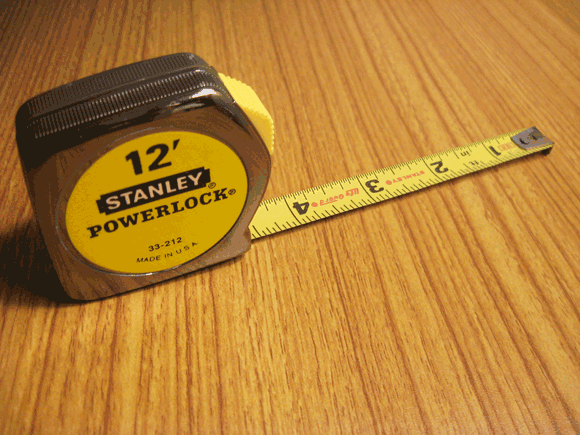
We start off with the obvious details: the larger numbers at the top represent inches, while the smaller numbers on the bottom of the tape indicate centimeters.
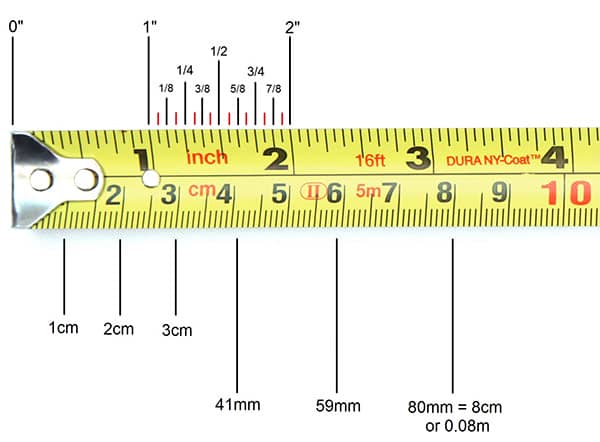
These circled Roman numerals are sometimes present in between and represent the level of accuracy of the measuring tape. The smaller the numerals, the more accurate your tape is. The tapes that don’t have these marks have no guaranteed level of accuracy.

The circled numbers on the left, shown in the picture below, represent the total length of the tape measure. The manufacturers print the length on the tape as it is required by the law.
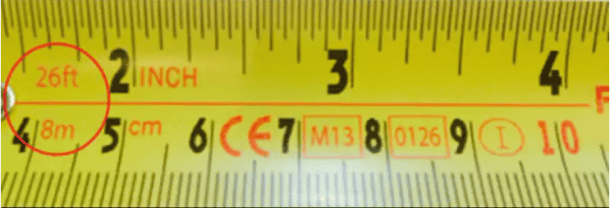
Now coming to the mysterious black diamonds, which may look like dark circles.

These diamonds appear at the 19.2-inch mark and allow the construction workers to make five trusses in an eight-foot space. Truss layouts or items are usually eight feet in length, and when you divide 8 feet (96 inches) into five, you get 19.2 inches.
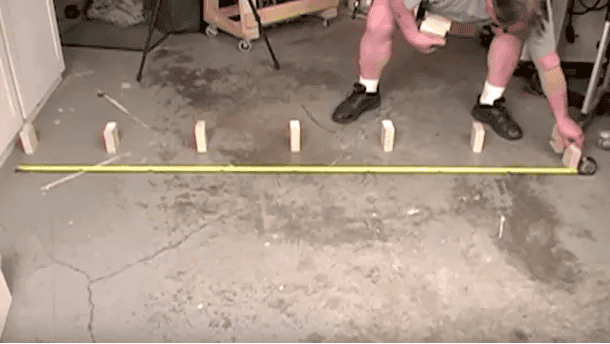
This accuracy would be difficult to achieve without these marks because of the decimal point. Hence, the diamonds are placed to end the hassle altogether. While the presence of these diamonds may seem trivial to the average Joe; it is vital for the construction workers as most of the American construction materials come in lengths of eight feet.
You now are an expert tape measurer!
You’re welcome!

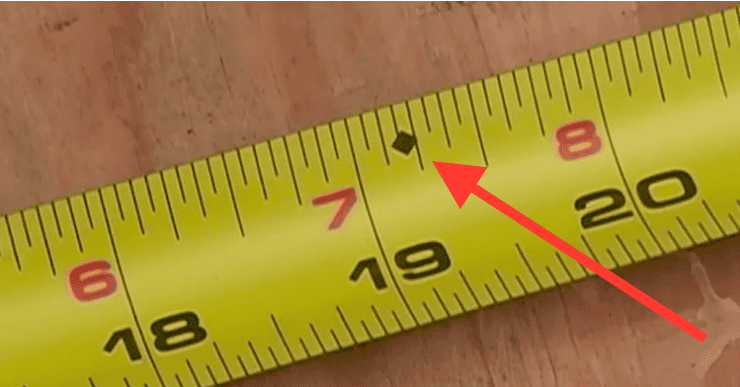

The black diamonds divide 96″ (8 feet into 5 equal spaces. Nothing more, nothing less.
When I started work in 1968 here in Queensland, Australia as a cadet Engineering Surveyor we measured everything in feet and decimals of a foot. We used an Invar steel band which was 100 feet long that had a low coefficient of expansion. We also had carpenters tapes which came from Canada as they were also decimal. A favourite trick to play on new offsiders was to show them the tape and tell them that there was now 10 inches in a foot.
I was a cabinetmaker/installer for 35 years. I found the imperial system vastly more accurate than the metric system. Parts and cabinets that I installed from a metric based country typically for me Canada were sloppy in sizing in my opinion. I preferred the more instinctual imperial because I can divide a pencil mark in four parts easily since it is instinct. I also have found there is no better tape measure than Stanley brand. They always served me extremely well. Long life, standout and accuracy. My favorite tape was the Stanley FatwMax in 16 feet. Even though I am retired I have one at hand always. As I am writing it is about 10 inches away. Haha. I had no idea about the black diamond. It is all in what you use that makes things such as that important.
Your black diamond theory is bullshit. Trusses are not set at 19 3/16 span. They are either 16″ On Center or 24″ on center.
I read your comment twice to see if I was reading correctly, how the hell can one system be more accurate than the other, the system doesn’t measure anything. The fact that the cabinets were sloppy in sizing is not an the metric system’s fault it is the cabinet makers fault. The only reason you prefer the imperial system is, it is what you are used to.
Great class !! I did not know what the black diamond was.
While 96″ ÷ 5 = 19.2″, your picture of 7 studs laid out over 96″ divides the board into 6 lengths of 16″, which is standard stud placement. So I’m still not sure what the 19.2″ measurement is for?
I design exhibition stands in the UK. We started to change to the metric system in 1978. One day our “tea lady” Margaret who was about 70 years old was pushing her tea trolley through the design studio, and our design director asked “Hey Margaret, what’s 2 inches in metric”? Without hesitation or missing a step she said “51 millimetres”. We were all flabbergasted that she knew, and it came from converting European knitting patterns to inches. She was absolutely spot on as 2 inches is actually 50.8mm. We thought then that if Margaret can do it then we can! It took a while (a few years) and from the mid 80’s the entire industry was 100% metric. I was working in San Francisco last week, and it seemed a bit odd working in feet for the stand size. The stand system supplied by a local US supplier was from Europe, and the stand construction measurements were all in metric, so it was quite painless.
By the way, I bought a very old book from a charity shop about 30 years ago, and one of the most interesting measurements was that there were three barleycorns to the inch. This is the measurement on which shoe sizes are based and still used to this day. A barleycorn is equivalent to 8.47mm.
Very weird……
On my tape measure the diamond appears at exactly 16″, the next one at 32″ etc.
Any explanation to this discrepancy with your tape measure??
And YES, the metric system is much easier than the imperial system
16 inch spacing is for stud placement in walls.
Typical 2×4 wall construction in the US is based on the “studs” being 16″ apart. So, maybe there are some tape measures for roofing contractors and some for framers???
Floors and wall studs are set on 16, 24. or 32 inch centers.
Just curious. Has anyone noticed, especially those whom are six feet tall, that the black marking at nineteen and three sixteenths inches happens to be a cubit? You know, elbow to middle finger tip?
I learned the metric system in the early 1970’s and was told that it would be fully in place by the end of the decade. Jimmy Carter abandoned the effort. Not sure what Ronald Reagan had to do with any of that. He wasn’t in office until Jan. 1981.
Just to make it clear to everyone in the United States, Ronald Reagan made it his mission to incorporate the Metric System in Metric Conversion Act, 15 U.S.C. 205d, enacted on December 23, 1975. NEEDLESS to say, it just wasn’t going to happen and ended the attempt in 1982…..
NEEDLESS to say, it didn’t happen because those responsible for the metric adoption were incompetent AND the average American was “accommodated” and totally unhappy in throwing their measuring tapes away along with all their fantastic fractions calculation skills…
@AJ. Reagaywasnt elected until 1981. Seems like it was someone else’s mission so NEEDLESS to say. learn your American History before trying to school every one else
“Learn your American History …” Take your own advice! Ronald Reagan was elected president in 1980, not 1981. He was inaugurated in 1981, yes.
Ok I will add my fun stuff. 67 years old, Machinist for 50 years. Both metric and inch work for me. But I have a third that when +/- .0005 isn’t necessary. My Machinists get broke in day one to it and my old timers just laugh at their confusion.
Working with a tech drawing they will run up on measurements like 3 1/4 + 2 or 3 1/4 -2. I started doing this to help one fantastic metal worker that worked for me for 22 years. He could barely read but was a master at metal. I could give him and drawing explain once then give him the Starrett rule I wanted him to work off of. 3 1/2 +1 to most would be 3.625. But to him it meant go to 3 and a half and add one tick on a 1/16th rule. Everyone has tricks. This helped a valued friend and work do his job, without embarrasment.
As an American, I can attest that if I had my choice, I would chose the metric system. It’s easier, easier to multiply and divide and trying to get 1.1414 from a foot is much easier using metrics rather than imperial. Sorry folks, our forefathers blew this one.
When Coke switched to a one liter bottle, did the world end.? Few noticed
If only everything was built out of coke bottles!
that was very helpful and interesting as my dad was a very good carpenter but I never knew how he knew how to mark the things he worked on. Thankk you.
Dumb Canadian Responding. Have you stopped to consider 19.2″ – 1.5″ – 1.5″ – tape stretch = 16″? This may help with conventional home building, no. That number may also be used for brick and block layers.
And metric is more accurate and faster to use and easier to remember. We get decimal inch drawings, need to convert to inch fraction then we can do our work on towers. Laying out many pieces of steel to drill is simpler and finer with metric. For things not so precise, use Imperial or Standard. I would love either side to concede, so we have less tools to purchase, cheaper vehicles because of ths dual dashboard diaplays and so on.
You will be grateful to know, S. Marker, that most newer cars which are sold in North America today have fully convertible speedometers and odometers. Yes, the actual motion of the dials on the speedometers can be reset, so that the dial, as it points to the numbers which are printed on the meter, will indicate miles, or kilometers, its your choice, and the odometer readings change too. To accomplish this, one simply has to consult their user’s manual, or play around with the settings long enough, and clever enough, to figure it out. How can you tell if your car has these options? Sometimes, all you need to do is look at the speedometer itself. If you only see numbers printed, and there is only a single set, and there are no calibration indicators, that is, MPH or KPH, actually printed on the dial, then your speedometer, with your odometer, is adjustable. I rent a lot of cars, S. Marker, and I drive through Upper Canada quite frequently, taking the short cut from Western New York to Detroit, Michigan and beyond, and so I have a lot of experience with this. The days of the double printed speedometers are pretty much over. Good news. Now, as for Metric, I will grant you that it is a vastly simpler system, especially for the sciences, with so much ease of interchangeability between units and such. But the Imperial System is more humanistic, as it was created by working people, in all sorts of crafts and industries, over the centuries, until at last it was standardized in Great Britain, and with just a few differences, by the Bureau of Weights and Measures in the States. I think that is fundamentally why people, even in Canada, and even in Great Britain, and in so many other places, still think, really, in Imperial measures. And if you actually visit Great Britain, and some other not so insignificant places, you will find road signs and such in Imperial Measures. And the truth is that the United States of America has only ever had one official measurement system, established as the ultimate standard for the resolution of such questions as may require measurements in the nation’s Courts, and with its Government, and that, going right back to the ratification of the Federal Constitution, as distinct from the older Articles of Confederation, from the time immediately following the Revolutionary War, and that is Metric. In truth, we simply use Imperial measures, even the Government and its agencies, because we prefer them. But officially, all questions or facts which must be determined by measures for legal purposes, such as in legislation and the functioning of the courts, must be at least available for consultation in Metric, because Metric is the only official measurement that the United States has ever had.
Whew I thought I was the only one who didn’t make sense of this
In Canada many of us have learned to use the imperial system from the previous generations yet we are also proficient in using the metric system professionally. As an electrician I use both systems interchangeably.
Noone cares about Canada
Yo! Dumbass! Withought Canada you wouldn’t have resources like hydro and potable water, our lumber and our oil. Keep your asshole comments to yourself!
Your delusional if you think the USA depends on Canada for everything you mentioned. The United States is energy self sufficient, including wood and power. That’s not staying both countries don’t trade in resources.
Is that all Canada offers, other than idiot presidents or prime ministers.
You stupid American. Stfu
I guess most Brits are not clever enough to drive on the right side of the road! It’s not about cleverness. It’s about getting everyone in an entire country on board with a completely different system all at once so that daily life can move on.
Just as the arrows at the progressive multiples of 16″ and 24″ centers for stud/joist/rafter layouts, the black diamonds on a tape are for layout of (expanded) metal lath (plastering trade).
the reason the US which is where I’m from uses both metric and standard is so that they can sell us twice as many tools as the rest of the world and we will buy them because we need them to work on all this mismatched crap
Us brits as you say because you measure in metric and standard. Just goes to show you are even thicker than us brits think you are It is metric and imperial not metric and standard thick one
Well, Colin, you are almost completely correct. However, minor liquid measurements are different in the United States. Gallons, Quarts, and Pints are a bit smaller in the United States. I believe that it is a question of standardization… The measures used for these units had become so common in the United States as essentially to be universal here, so that when the units were fixed to a different standard within, across, and for the purposes of administration and trade within the British Empire, the United States neglected to follow suit, as the units used here, which were included amongst the numerous variations used within and across the Empire before standardization. The term “standard”, which we use here so commonly for the Imperial System, (with one small exception) is simply the most common way of referring to our popular measurement system here. It probably comes in part from the Society of Automotive Engineers (SAE) and other non governmental agencies and such which use the term. But the truth is that none of all of this is official. Certainly, the Bureau of Weights and Measures takes tremendous care to define, for instance, the actual length of a yard, or a mile, with tremendous scientific accuracy. However, there has only ever been one official measurement system in the United States of America, and that is the Metric System, as all questions requiring the use of measures, as they may be subject to official question or debate must be made available in Metric, and legally binding standards can only be set, and questions involving measures can only be answered, in the end, in Metric, where the Federal Government is concerned. As for the rest of it, from the utensils in our kitchens, to the components which comprise the many and fine automobiles which we so proudly manufacture, to even the designing and launching of our rockets and such by NASA, is often or always accomplished either with Imperial Measures, with our few exceptions, or some combination of Imperial and Metric, because this is how we wish to do these things. The United States is simply not the sort of nation where the national government is expected, desired, or even empowered to establish and enforce standards of measure. It is enough that the Federal Government, with its Bureau of Weights and Measures, and its regulatory agencies and courts, insists and ensures that A Pint is a Pound the World Around, at least as we have established, accepted, and agreed what a Pint and a Pound indicate, here, in this place, at this time, and in this context. In the end, we do not have a unitary state. The USA is truly a Federal Republic, and that means that each of our fifty states retains its sovereignty, as a state, and NOT a province, or a prefect, or something like that. It’s the same for the District of Columbia, and for our allied commonwealths. The US government functions as a unitary sovereign only over and in our territories, and even there, it’s with a pretty light touch when it comes to so very much. So, the very idea that the Federal Government could or even would enforce a unitary standard of measure its states, and their respective residents, agencies, governments, societies, cooperatives, or corporations, is, perhaps bizarrely for many who are less familiar with our system of government, and our political society and culture, really quite foreign to us, and that is why, most essentially, the American public, with our corporations and so many organizations and agencies of civil life, reacted so very badly to President Carter’s efforts to convert the nation to even the popular use of Metric. That, for most people, is simply NOT what the Federal Government is supposed to do. And in truth, Constitutionally, historically, legally, and practically, those people are correct. In fact, they have the Federal Constitution, and the very historical and cultural spirit of our nation on their side. If we ever really convert to Metric, it will be by consensus. Now, there is your short course in American Political Science for the day, from, yes, a Political Scientist who, this night, suffers from insomnia….
I got metric up and down, and on both sides, no problem… ?
Metric tapes are good if you have a British woodcarving magazine or construction directions from somebody in Europe.
ummmm. Ok, I don’t think that was very clear. My understanding is that the black diamond at 19.2″ is mainly because although you would place PINE joists at 12″ of 16″ for floors, you are permitted by code to place P-lam (manufactured laminate) joists farther apart and still be structurally equal to Pine joists at 16″ O.C. so putting a diamond at 19.2″ to allow quick layout. I’ve no idea what they are talking about regarding five trusses in an 8 foot span because material is 8 foot???
How about no. Roof trusses are not laid out at 19.2″. They are either laid out at 16″ on center or 24″ on center.
am I missing something?
That and metric is a better system 😉
I’ve never heard of truss layout on 19.2 centers, but it is used on floor joist layout using 7/8 ply.
Floor trusses are a layout of 19.2
I’m surprised nobody has mentioned the fact that most imperial tapes also have a red marking every 16″ for studs spacing in a wall.
For those attached to the imperial system because it’s patriotic, I say this: I better see you building using nothing but flat head screws since that’s the head that was created in the US. Everytime I look at a plug cover I wonder who the patriotic genius was who thought using the only screwdriver head that stands a chance of slipping and getting cough in the plug, thus electrocuting the user.
We had flathead screws in europe before America had screwdrivers!
Us brits as you say because you measure in metric and standard. Just goes to show you are even thicker than us brits think you are It is metric and imperial not metric and standard thick one
You must be really thick flat blade drivers were being used in the UK and Europe before we came over in The MayFlower. Flat blade drivers are a thing of the past pozi drive or Phillips are the future. Same as to Torx has taken over from Allen screws. Therefore wake up smell the coffee and get your head out of the sand you moron
I wonder how many of you “young bucks” out there know what the horizontal “hole” is for on the “L” shaped clip on the leading end of the tape itself? And also, at the trailing end of the tape, there is another “hole” in the “tongue” onto which the tape is fastened, how is THAT “hole” used? All you oldsters take a break now …..
It is used to grab ahold of a nail.
50 years ago,when I was a wee student…we were taught the metric system, we were told then that “our” system would be changing and we would be using the metric system in the “near” future. The problem is our politicians…ain’t the smartest people. Over time Industry converted to the metric system…I’ve used it in several different work environments. By now everyone was supposed to be MUCH smarter…but, alass…it is not to be. Students now days can’t even make change without using a calculator, and our American politician’s…well, they can’t find their mass with both hands.
Amen
“alas”
I suppose the Americans were clever enough to use feet and inches well enough to build ships, planes and tanks that kept our friends who use the metric system from having to speak the German language.
The only reason you joined the second WWar was the Japanese bombed Pearl Harbour and as usual you stopped that conflict with ENOLA GAY and the A bomb. Until Bin Ladin bombed on American soil it was ok for your arms dealers to give arms to the Talliban
The cabinet industry uses both metric and imperial. The 32mm system for hardware since most is from Europe and inches to make sense to customers.
Money just think how much it cost. And thebillions that were made to stork the industrys in this country. Money never used it when i was a kid
Ignorance is bliss. I once suggested metric to a calm neighbor who was a banker. He went blastic that I would suggest a non patriotic scheme used by all but the USA and a few 3rd countries. A 1x1x1 cm of water weighs a gram. To heat it 1 degree takes a thermal unit. I can make a box that holds a liter of water, know it’s 1000 cubic centimeters, know it weighs 1kg, and how much heat to warm it 10 degrees without a calculator. But no, here I’m on a ladder trying to 2 feet 3-7/64 inched by 4 so my coat pegs will be even…..Also those tapes with inches and mm are useless, I end up with mm aganist the object trying to sight across the tape to read inches. If I have to use inches I want it on both edges of the tape.
I guess most Americans are not clever enough to learn or understand the metric system
I would love to have a tape measure which bottom number are twice the top. Any idea where to buy one?
…and I would love a tape with ONLY millimeters units! Still looking for one to buy.
I have seen all metric tapes at Home Depot and Lee Valley
You can buy from RSA they only work metric
Roberto – I just bought a Luftin tape measure from Lowe’s that has the bottom number 1/2 of the top. Therefore the top is double the bottom.
Woodcraft stores sell 4 or 5 different kinds and can show you uses. Woodcraft is the woodworkers favorite store.
Thanks a lot for the new information. My bet is a lot of us so called backyard carpenters didn’t know about the black diamond’s. I do now and it could come of use in the future. Thanks again
The Imperial system is used by USA, Myanmar and Liberia. Ita a small world indeed. LOL.
The Imperial system is used by USA, Myanmar and Liberia. Ita a small world indeed. LOL.
Engineering makes the world go round
8 feet? 96 inch? LOL, when you pass to the decimal system it will always be too late…
I still use feet and inches, it is used by millions and is the World standard.
WORLD STANDARD???? ONLY 3 countries use the Imperial system….
No, it’s not! The most country uses the metricsystem.
World standard??!! Hahahaha!!!!You probably never left your neighborhood and are discoursing about “the world”. Check your computer on google, wikipedia or ANY other source. Now you can continue transforming inches in decimal to enable arithmetics…
Actualy, divide 250 cm by 5 is quite more easy and not necessitate this black diamonds. It is interesting to see how they find a tricky way to ease the work with the old system rather than use a clearly simple system !
I guess most Americans are not clever enough to learn or understand the metric system
Right or wrong the imperial system was what we were taught. Clever has nothing to do with it! Why would one learn a system that isn’t used in their country? It is as common to us as being rude is for some folks.
I guess most Brits are not clever enough to drive on the right side of the road. It’s not about cleverness or about patriotism. It’s about converting a system across an entire country ask at once
I guess most Brits are not clever enough to drive on the right side of the road. It’s not about cleverness or about patriotism. It’s about converting a system across an entire country all at once, smoothly so that daily life can go on. Most people would have trouble getting more than a couple hundred people to work synchronously well.
We Americans were clever enough to kick your butts over 200 years ago and you “clever” brits w/b eating kraut and boiled potatoes twice a day without us. We pulled your bacon out of the fire twice and what did you give us? A disgusting way to eat pudding!
Exactly…
When I told “exactly” above I was addressing Mr. LeLoupBlanc. To Ms. Sherrie Olson I need to say that your text is nonsense: Even being wrong you’re using because your teachers told so??!! If imperial was better I would override my school and buy inches and feet tapes…